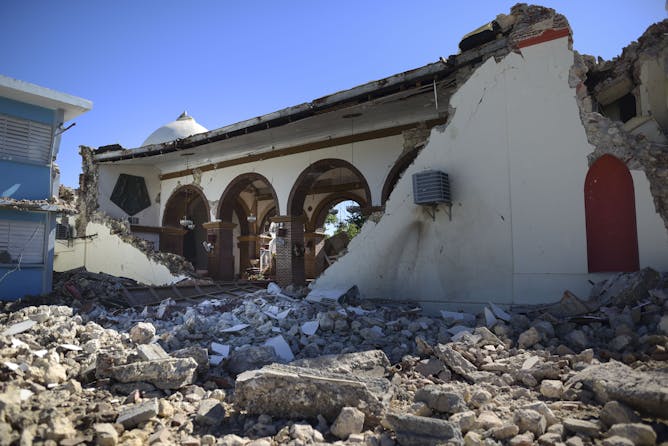 |
A note from...
Jennifer Weeks
Environment + Energy Editor
|
|
|
On Jan. 6 and 7, Puerto Rico was struck by two major earthquakes that left one person dead and thousands without power or running water. But as anyone who has been through a major quake knows, they aren’t a single event – they typically generate numerous aftershocks, and some, like Puerto Rico’s, are preceded by foreshocks.
As Colorado State University geophysicist Rick Aster explains, it’s almost impossible to predict the precise timing, location or size of a quake in advance. But once one occurs, scientists can make forecasts about whether more are likely to follow. Puerto Ricans can expect dozens more aftershocks large enough to feel before this event finally ends – a challenging start to 2020 for an island still recovering from past
disasters.
Also today:
|
Top story
|

The Immaculate Conception Catholic Church lies in ruins after a magnitude 6.4 earthquake in Guayanilla, Puerto Rico, Jan. 7, 2020.
AP Photo/Carlos Giusti
Richard Aster, Colorado State University
Puerto Rico's January earthquakes came after many foreshocks and have been followed by numerous aftershocks. Scientists are studying these sequences to improve earthquake forecasting.
|
Politics + Society
|
-
Dennis Jett, Pennsylvania State University; Amy Dacey, American University; Pearl Dowe, Emory University
At the Jan. 14 debate, held at Drake University in Des Moines, Iowa, six candidates clashed on jobs, Iran and more.
-
Monti Datta, University of Richmond
Since President Donald Trump took office, Iranians have held a more unfavorable view of the US.
-
Morgan Marietta, University of Massachusetts Lowell
The question facing justices isn't whether the president had the authority to rescind DACA. Rather, it is: Was he honest in his reasons why?
-
Carol Nackenoff, Swarthmore College; Julie Novkov, University at Albany, State University of New York
If upheld, a federal court ruling would solidify birthright citizenship as the law of the land, and overturn more than a century of federal refusal to grant American Samoans citizenship status.
|
|
|
|
|
|
|
|
Most read on site
|
-
Ashima Krishna, University at Buffalo, The State University of New York
In up-and-coming neighborhoods, old churches are often converted to apartments or offices. But what about the vacant or underused churches in areas that aren't attractive to developers?
-
Patricia L. Foster, Indiana University
Norovirus, the winter vomiting bug, is highly infectious among people in confined places – like cruise ships. But not everyone is equally vulnerable. Your blood type may determine if you get sick.
-
James Carmody, University of Massachusetts Medical School
Are you a worry wart? Not to worry. Turns out you were born that way, to some degree. Humans have a default mode in their brains that lead them to worry, but there are many ways to switch gears.
|
|
Today’s chart |
-
  |
Monti Datta
University of Richmond
|
| | | |
| |
|
|
|